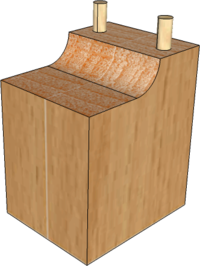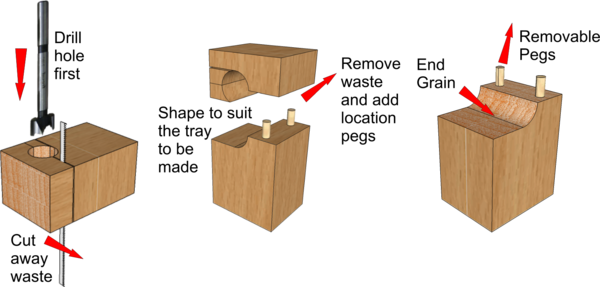Sinking Block
From DT Online
Description
Sinking is a process used to create flat, shallow tray shapes (i.e. Flatware) by beating an Annealed sheet metal shape into a recess formed in the end grain of a suitable block of close-grained Hardwood known as a Sinking Block.
Features and Uses
Sinking Blocks are usually self-made as required with removable pegs to maintain a constant width of rim where needed. A suitable manufacturing procedure is shown below:
- first, a block of close-grained Hardwood is drilled through towards one end with a drill diameter twice the required recess depth (e.g. using Forstener Bits);
- then the waste is removed to reveal the required 'step'.
- Removable pegs are added to complete the block ready for Sinking.
- 12oz Hammers (0.45kg) are a good useful size for general work in Design and Technology.
- Larger 2lb hammers (1kg) are used for heavier work such as Blacksmithing for example.
- Smaller hammers (e.g. 4oz and 8oz) are suitable for jewellery work and model engineering applications.
- Brick Hammers between 1lb and 1.5lb weight (450g to 700g) are suitable for school use and are available also with a Scutch Comb Chisel at one end which can be used for shaping brick and masonry.
- A 2lb Lump Hammer (0.9kg) is a good useful size for general work in Design and Technology and home maintenance tasks.
- 2lb to 4lb Sledge Hammers (1-2kg) are a suitable size for general forge-work in Design and Technology since hammers heavier than 4lb would be difficult for students to use.
 |
 |
 |
 |
 |
 |
 |
 |
| Ball Pein Hammer |
Blacksmiths Hammers |
Brick Hammer |
Claw Hammer |
Cross Pein Hammer |
Lump (or Club) Hammer |
Pin Hammer |
Sledge Hammer |

